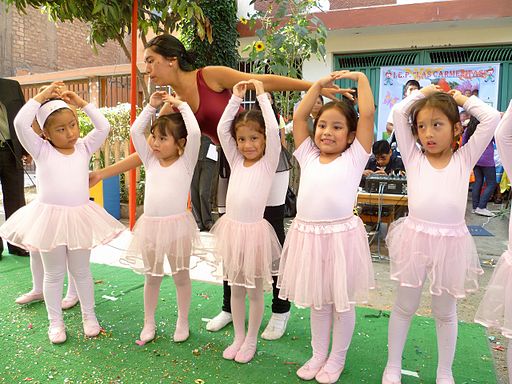
Over the last few years of teaching dancing, I have noticed that I have had more and more cases of children attention deficit disorders.
I can’t quite put my finger on when these numbers started increasing to the level that it has now gotten to, but suddenly there are about two in every four classes, whereas before I maybe had two in my entire studio.
What Is Attention Deficit Disorder?
Attention-deficit or hyperactivity disorder is defined as a persistent pattern of inattention and/or hyperactivity that is more frequent or severe than expected for a given level of development.
Children with ADHD have difficulty paying attention and focussing their attention to details. They also find it difficult to follow through with instructions. They battle to organize tasks, misplace their belongings often, are forgetful and are very easily distracted.
In class, the child will find it very difficult to sit still and will fidget and blurt out answers. They tend to talk a lot and interrupt other conversations and games.
Children with attention deficit disorders aren’t able to wait their turn. Background noise can make it worse for them.
Unfortunately, this sort of behaviour often attracts negative attention from teachers and classmates, and because of the rejection and criticism, it can lead to asocial behaviour, withdrawal and depression.
More About Children Attention Deficit Disorders
Children have different kinds of learning problems, but ADD or Attention Deficit Disorder seems to be the most common at the moment. The child is not always hyperactive, he could just have an exceptionally short attention span.
Many adults nowadays also have ADD.
In most cases, doctors have recommended that the children be put on Ritalin or a similar drug. In some cases, the child can be helped with more natural alternatives.
Other common symptoms for children attention deficit disorders include:
- Impulsivity
- Restlessness
- Poor organizational skills
- Procrastination
- Willful
- Stubborn
- Tend to have a lot going on at once but fail to finish anything
- Have a strong desire to be free and independent
- Love excitement and danger
- Get bored quickly
- Don’t follow at an organised pace easily
It’s not all bad though. On the positive side people who suffered from this disorder in the past have been visionaries, dreamers, explorers, inventors (Edison was a classic), path-finders, entrepreneurs (almost all entrepreneurs have ADD), creative types, original thinkers, paradigm breakers, trend-setters, freethinkers, as well as being big-hearted, trusting, generous, and fun.
So rather think of an attention deficit disorder as a condition that can be associated with tremendous success in the end.
You can read more about treatment for ADD here.
Children Attention Deficit Disorders And Teaching Them
It is a concern, and the child does need to be helped if he or she is to function normally and progress at school or in extramural activities.
Having a hyperactive child in a dance class is no fun for the teacher or the rest of the students in the class who are there to learn.
Instead of standing still and listening to what you are saying, the child is either swinging on the bars or running circles around the other children.
As a dance or ballet teacher, it is very difficult to control a class that has a child like this in it, and sometimes the only remedy is to let the child seek treatment and return to class once he or she has calmed down.
As a teacher, you are going to need great levels of patience, consistency, and creativity to get these children to concentrate on something long enough to get it right.
If I see bad behavior coming, I try to ward it off by giving the child something to do, like the handing out of props to the other children. Try to stay positive and reward the child with lots of praise when he or she does well. Offering rewards for hard work also help, like stickers or a star next to his name on the chart.
When teaching the attention deficit child, make sure that you explain things very clearly and again if necessary.
Try to do the most difficult steps at the beginning of the class while they are still fresh.
If you need to teach a long dance, break it up into segments and teach bit by bit. Repetition is key, as often the first time that you explain something, the child’s mind will be elsewhere.
Keep the class moving at a rapid pace. ADD children get bored easily, so keep them moving, even if it is just to repeat steps.
If you have some children attention deficit disorders in the class, please let us all know below what you do when you teach them and let us share our ideas.


Wow Michel
This is most certainly something I have had to deal with in class at school. As you say, it is getting more and more common these days.
As a school teacher, it can be difficult to manage, I honestly had never thought quite how hard it would be in a dance class situation, where you only have such a small window of time with them each week, and limited time to establish a strong relationship with them,a s we would as a school teacher.
I think what you say is right, sadly, that finding them things to do to sidestep boredom is essential. It is so sad for them that even though they may really desire the dance, they are unable to fully engage as others would.
Thank you so much for your insight and thoughts, it has really struck me as an important aspect of where our society and children are headed.
Best regards
Cindy
Well, my daughter could easily be this child who has ADD or ADHD and today she told me she was going to dance like a ballerina, and I thought maybe someday.
Although I have no doubt including a child who is hyperactive in your classes is a big challenge, I know that for kiddos who struggle with ADD/ADHD and little ones, like mine who are autistic, being able to find a way to direct their energy and engage with music is mentally and emotionally healthy for them.
I applaud your attitude and efforts to find ways to keep these little ones in your class. Recently, the statistic is that 1 in 88 children is autistic so that is a growing problem that interfaces with the one you have observed in your class for attention and focus. Maybe as you discover even more techniques for including them, you could promote a class just for special needs and ADD/ADHD kids. While it would be work, my guess is it would be VERY rewarding. You should see my little one’s excitement when she can accomplish something. It would make your heart smile.
Thanks for the recommendation for the Synaptol product. If I had the money for it I would be purchasing it today. I will come back and check for it early next month and will bookmark your site now as a reminder.
Linda
Thank you for your comment.
Let your daughter dance as it is an excellent way to get rid of all that pent up energy. In most cases I have seen it gets easier as they get older.
Kids with these types of disorders can be difficult to teach, but it is so worth it when you can help them learn something new. They light up! It is so worth it. Your patience will be repaid many fold.
I’ll tell you what some of the speculation is out there regarding ADD, and it has a lot to do with lifestyle changes in children. Probably one of the single most important elements is a child’s diet. When you go into the grocery store, about 90% of the food is edible product, which doesn’t contribute to the well being of a child. How many cereals did you have as a child? Now there’s an aisle devoted to it. This just scratches the surface, but there’s a lot of improvement needed and as you see first hand, it impacts everything right down to dance classes
Thanks for your comment Frank. Yes that’s another big part of it and a great topic for another post.
Hi,
great page. I’m not sure about ADD. I’m not sure about giving kids drugs for it. I would use natural remedies myself. I was wondering if you know the cause of ADD. Could it be electronic devices, video games, smartphones creating attention problems in kids and adults? I wonder what’s going on, and why there are so many cases of ADD. Something’s not right. Maybe we all should step away from the new technology for a while?
You could be right there. ADD children have a lot going on in their brains, and all these gadgets could be complicating things.
Hi there,
You have some really good points on teaching ADHD student. Keeping instructions short, repeating them as needed (which can be often), moving the class through task quickly so the ADHD child doesn’t get too distracted are all great points and not only in teaching dance but also in other situations as well.
Thanks for the information
Thanks for your time and glad I could help.
When I used to work with children I found it very difficult to work with hyper children (even without the diagnosis), and your tips are definitely helpful. Keeping them moving is a huge help. I found even with children who were just typically hyper, active and bored easily you have to keep things moving and exciting, interesting and hands on. Children cant be expected to stay still and listen for long periods, they learn through ‘doing’ and by participation, and that isn’t different in adhd children.
I think also it is a good idea to get them to have input, like what they want to do and what type of music do they want to start with, because giving them this power allows them to focus more and feel they are in control of the situation.
Those little ballerinas are too cute
You are absolutely right Nae. Thanks for your thoughts.
Thanks for the informative article. Working in special education, I have had experience with ADD and ADHD on a daily basis and I always struggle with the medication side of it. As you mention in your article, some of the most influential people in history showed signs of having the “disorder” and yet it is because of these different traits that they were able to be so creative and succeed at such a high level.
It worries me sometimes that we look at it as such a problem and immediately move to medicate because we need kids to fit into this school-specific box of sit still and listen when not everyone learns that way. It makes me wonder how much creativity and ingenuity is being stifled because these kids don’t fit the mold.
I think, as you say, communication between parent and teacher is key to best serving the child.
Quite right Steve, that’s why its important to get the correct diagnosis in the first place and then try to go natural first. Sometimes even a simple thing like changing their diets can go a long way.
I have friends where their child is ADD. To keep them focused is really difficult. But why do we need to keep them focused?
These type of children are very creative. They are often able to create magic when you least expect it. I don’t think we should treat them the same as what the society expect. Rather we should let their creativity flow.
Quite right Florence. The only problem is in a class situation, they could disrupt the other children’s concentration. It is maybe best to have a separate class for ADD where they can learn in their own unique ways.
Our grandson is a very high energy boy who is also extremely smart. There are times when we’ve wondered whether he has an attention deficit disorder because he seems to go from one thing to another so fast and it can be hard to get him to stay focused. He’s very artistic and loves to draw, sing, and dance. Keeping him busy with tasks that challenge him and letting him have an outlet for his energy are key.
I love that you have such a good understanding of how to handle these type of children and they can flourish in your classes.
Thanks Janelle.
They usually get better over the years and in the end you do end up with a good student, provided they get the correct diagnosis and treatment as they grow up.